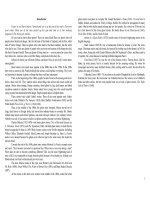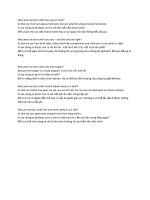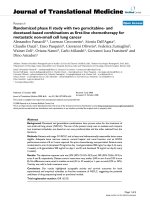Switchable bandpass filter with two state frequency responses
Bạn đang xem bản rút gọn của tài liệu. Xem và tải ngay bản đầy đủ của tài liệu tại đây (326.93 KB, 2 trang )
Switchable bandpass filter with two-state
frequency responses
The input impedance for even-mode and odd-mode can be expressed as
Zine = jZ1
B. Lui, F. Wei and X. Shi
A novel switchable bandpass filter with two-state frequency responses
is presented, where dual-band bandpass and single bandpass characteristics can be conveniently switched by turning pin diodes on and off.
The switchability results from the effect of different working modes.
The filter can work as a dual-band bandpass filter obtaining two
centre frequencies, 1.8 and 3.5 GHz, which could be appropriately
used for GSM and WiMax systems. In the meantime, it also can
operate only at 3.5 GHz, rejecting signal at 1.8 GHz. The proposed
filter consists of two dual-mode resonators, using pin diodes to
switch the frequency responses. An experiment was carried out to
validate the design concept, and the measured results agree well with
simulated results.
Introduction: Electronically switchable and reconfigurable microwave
devices such as filters are in great demand for existing wireless communication systems, and this trend will continue for future systems.
To meet the increasing requirement of modern multi-functional
systems, bandpass filters (BPFs) should have multi-frequency response.
Switchable BPFs can be used to control the spectrum of proposed
signals and support multiple information channels [1, 2].
In some cases, there is a requirement for switchable BPFs to have
dual-band bandpass and single bandpass characteristics. Much research
work has been performed and various methods have been designed to
realise dual-band behaviour. Among them, there are two typical
methods. The first category is to combine sets of independent resonators
with common input/output ports [3, 4]. The second is to utilise stepped
impedance resonators [5, 6]. However, dual-band BPFs designed by
these methods cannot be conveniently switched to operate in one passband. In this Letter, a novel structure to implement dual-band behaviour
is proposed, and the filter employing this structure can be easily
switched to operate in one passband. With the pin diodes on, a shortcircuited stub is loaded in the centre of the open-loop resonator to
obtain a dual-mode dual-band BPF. By turning the pin diodes off, the
stub is disconnected with the open-loop resonator, and the filter has
only one passband. The passband frequencies can be easily controlled
by tuning the length of the stub and the open-loop resonator. Based
on the above principle, the switchable BPF operating at 1.8/3.5 and
3.5 GHz is designed and fabricated. The EM simulated and measured
results are present to demonstrate the performance of the proposed filter.
L1
DC
s
Zino = −jZ1 cot(bL1 )
(1)
(2)
where b is the propagation constant, and it is equal for even-mode and
odd-mode. The resonance condition is
Zine
1,
Zino
(3)
1
By solving (3), the fundamental resonant frequency can be determined
as follows:
feven =
c
√ ,
4(L1 + L2 ) 1e
fodd =
c
√
4L1 1e
(4)
Apparently, the odd-mode resonant frequency fodd is larger than the
even-mode resonant frequency feven . fodd is only determined by the
length of the open-loop resonator and the length of the short-circuited
stub only influences feven . In our design, the odd-mode resonant frequency fodd is 3.5 GHz, and the even-mode resonant frequency feven is
1.8 GHz. When the pin diodes are in the ‘ON’ state, the short-circuited
stubs are connected. The existence of both even-mode and odd-mode in
the resonators results in a dual-band bandpass response. Under this state,
the filter obtains two passbands ( f1 ¼ 1.8 GHz, f2 ¼ 3.5 GHz). When
the pin diodes are in the ‘OFF’ state, the short-circuited stubs are disconnected with the open-loop resonators. There is one mode in the resonators, and thus the filter has only one passband ( f1 ¼3.5 GHz). The
bandwidths of the two passbands are mainly affected by the coupling
structure, and the desired bandwidths can be acquired by choosing
proper dimensions of the coupling structure. Based on the above analysis, the filter is designed to operate in two different states by turning the
pin diodes on and off. Infineon pin diodes BAR63-02V in a SC79
package are used to connect the stubs, which have a capacitance of
0.22 pF, a parasitic inductance of 0.6 nH, and a resistance of 1.2 V at
100 MHz.
The filter is fabricated on a substrate with dielectric permittivity 1r¼
2.65 and thickness h ¼ 0.8 mm. The fabricated filter with DC bias is
shown in Fig. 3. The final optimised parameters of the filter are listed
as follows: L1 ¼ 1.6 mm, L2 ¼ 5.2 mm, L3 ¼ 3 mm, L4 ¼ 2.5 mm,
L5 ¼ 11.8 mm, w0 ¼ 2.2 mm, w1 ¼ 1 mm, w2 ¼ 0.9 mm, w3 ¼
0.5 mm, g1 ¼ 0.7 mm, g2 ¼ 1.1 mm, s ¼ 0.18 mm, L¼ 27 nH, R ¼
1 kV. The overall size of the proposed filter is 30 × 30 mm2.
L2
g1
L3
L5
Z1 tan(bL1 ) + 2Z2 tan(bL2 )
Z1 − 2Z2 tan(bL1 ) tan(bL2 )
L4 D2
g2
D1
w2
w0
w3
w1
L
R
DC
Fig. 1 Schematic of proposed filter
Z2 , L2
2Z 2 , L 2
Zine
Z1 , L1
Z1 , L1
a
Zino
Z1 , L1
b
Z1 , L1
Fig. 3 Photograph of fabricated filter
c
Fig. 2 Structure and equivalent circuit of dual-mode resonator
a Dual-mode with short-circuited stub
b Even-mode equivalent circuit
c Odd-mode equivalent
Filter design: The schematic of the proposed BPF is shown in Fig. 1.
The filter is composed of a pair of coupled microstrip open-loop resonators and two short-circuited stubs. The external coupling is established
by edge coupling. As depicted in Fig. 2a, the resonator with the shortcircuited stub loaded is symmetrical, and then odd- and even-mode
analysis can be applied to characterise it. For even-mode and oddmode excitation, the equivalent circuit is shown in Figs. 2b and c.
ELECTRONICS LETTERS 6th January 2011 Vol. 47
Simulated and measured results: Simulation and measurement were
carried out with EM simulation software HFSS 11.0 and an Agilent
vector network analyser N5230A. Fig. 4 shows the simulated and
measured scattering parameters when the pin diodes are in the ‘ON’
state. It can be seen that the proposed filter can operate at 1.8 and
3.5 GHz, and the measured fractional bandwidths are 9% in the lower
passband and 7% in the upper passband. Fig. 5 shows the simulated
and measured results when the pin diodes are in the ‘OFF’ state.
According to Fig. 5, the filter obtains only one passband. The measured
results agree with the simulated results, which validates the design.
Insertion loss is nearly 3 dB in the lower passband, a little higher than
that of the simulated results, which mainly results from the resistances
of the pin diodes.
No. 1
0
tuned in two states, operating as a dual-band bandpass filter, or just
having one passband. Experimental results agree well with simulated
results, and show good performance. Because of its simple structure,
compact size, and good performance, the proposed filter is attractive
for use in GSM and WiMax systems.
|S11| and |S21|, dB
S11
–20
S21
# The Institution of Engineering and Technology 2011
7 November 2010
doi: 10.1049/el.2010.3156
One or more of the Figures in this Letter are available in colour online.
–40
simulated
measured
B. Lui, F. Wei and X. Shi (National Key Laboratory of Science and
Technology on Antennas and Microwaves, Xidian University, Box
223, No. 2 South Taibai Road, Xi’an, 710071 Shaanxi, People’s
Republic of China)
–60
1
2
3
frequency, GHz
4
Fig. 4 Simulated and measured results with pin diodes on
E-mail:
0
References
|S11| and |S21|, dB
S21
–20
S11
–40
simulated
measured
–60
1
2
3
frequency, GHz
4
Fig. 5 Simulated and measured results with pin diodes off
Conclusion: A switchable bandpass filter with two-state frequency
responses has been developed. The proposed filter can be conveniently
1 Wong, P.W., and Hunter, I.C.: ‘Electronically reconfigurable microwave
bandpass filter’, IEEE Trans. Microw. Theory Tech., 2009, 57, (12),
pp. 3070–3079
2 Tu, W.-H.: ‘Swithable microstrip bandpass filters with reconfigurable onstate frequency responses’, IEEE Microw. Wirel. Compon. Lett., 2010,
20, (4), pp. 208–210
3 Zhang, X.Y., and Xuei, Q.: ‘Novel dual-mode dual-band filters using
coplanar-waveguide-fed ring resonators’, IEEE Trans. Microw. Theory
Tech., 2007, 55, (10), pp. 2183–2190
4 Dai, G.-L., Guo, Y.-X., and Xia, M.-Y.: ‘Dual-band bandpass filter using
parallel short-ended feed scheme’, IEEE Microw. Wirel. Compon. Lett.,
2010, 20, (6), pp. 325– 327
5 Shi, J., and Xuei, Q.: ‘Novel balanced dual-band bandpass filter using
coupled stepped-impedance resonators’, IEEE Microw. Wirel. Compon.
Lett., 2010, 20, (1), pp. 19– 21
6 Tsengand, C.-H., and Shao, H.-Y.: ‘A new dual-band microstrip
bandpass filter using net-type resonators’, IEEE Microw. Wirel.
Compon. Lett., 2010, 20, (4), pp. 196–198
ELECTRONICS LETTERS 6th January 2011 Vol. 47 No. 1









